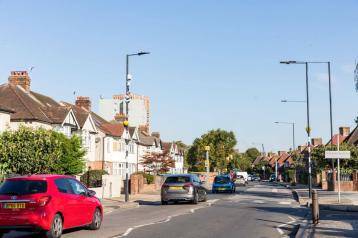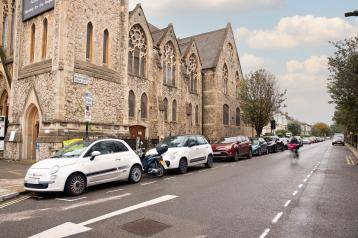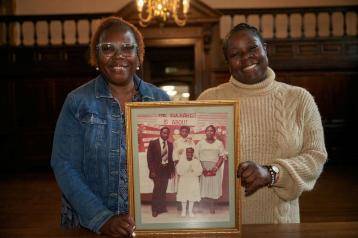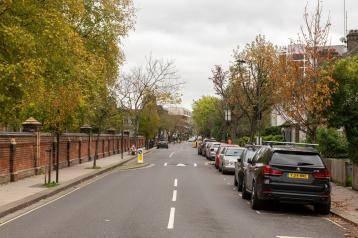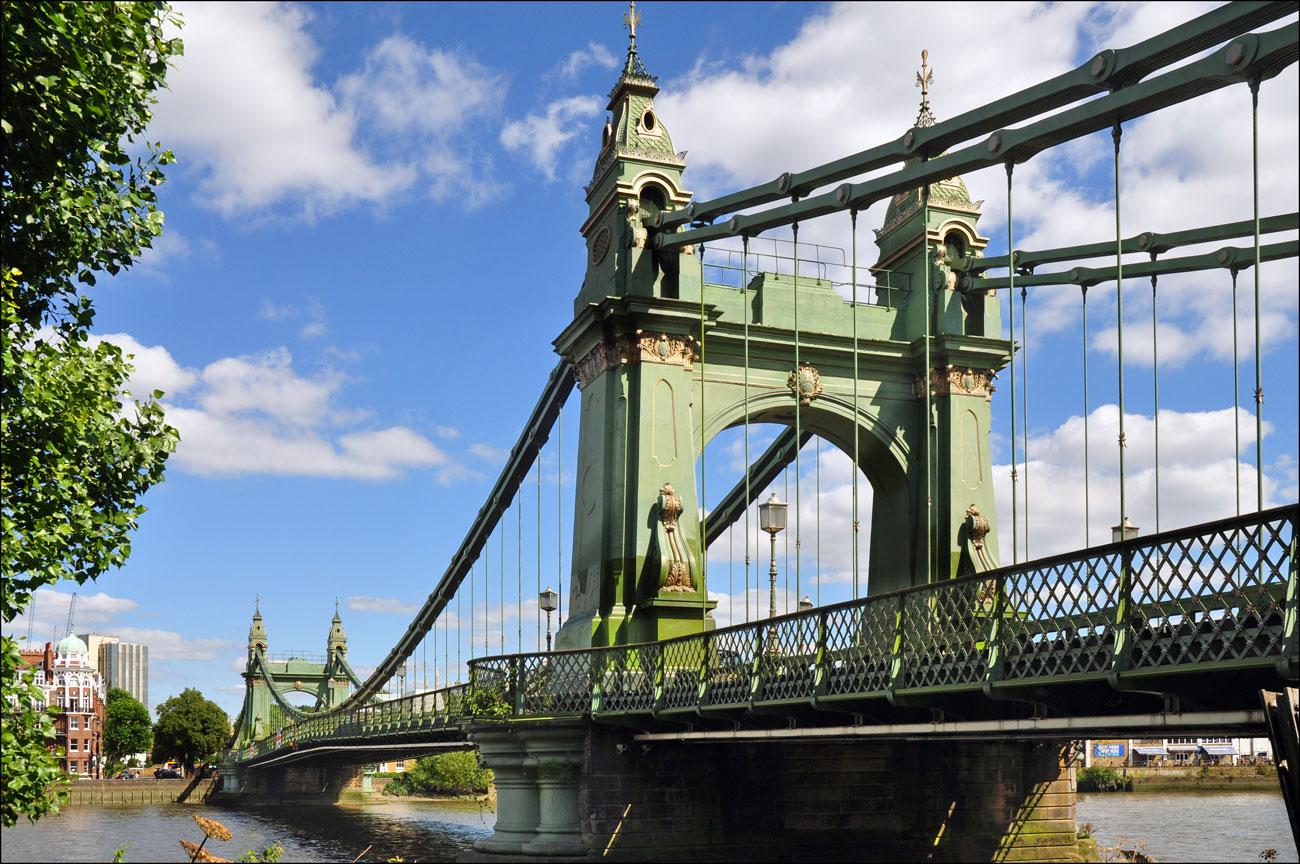
- CCSO gives H&F Council green light to bridge re-opening
- Decision follows review by safety experts
- H&F repair plans will avoid major bridge closures
Hammersmith & Fulham Leader Cllr Stephen Cowan re-opened Hammersmith Bridge on Saturday 17 July to pedestrians, cyclists and river traffic.
The decision followed a series of comprehensive safety investigations into the bridge and the successful introduction of an innovative temperature control system that helps prevent cracking in the 19th century cast iron pedestals.
Cllr Cowan announced the decision during a meeting with engineers at the bridge alongside Cllr Gareth Roberts, Leader of Richmond upon Thames Council.
Cllr Cowan said: "I am very pleased to confirm the latest advice from safety engineers is that we can safely re-open Hammersmith Bridge.
"I know how difficult the last 11 months have been for people, particularly children needing to cross the river to get to school and those who need to attend medical appointments or get to work."
VIDEO: Cllr Stephen Cowan reflects on the reopening of Hammersmith Bridge
Putting public safety first
Cllr Cowan added: "The potential for catastrophic collapse of this 134-year-old suspension structure was very real. We've employed the best engineers from around the world who advised we had to close the bridge last summer. We will always put the safety of the public first.
"Ever since, I have been determined to re-open the bridge as soon as it was safely possible. The introduction of the temperature control system, and the results of our extensive engineering investigations, now mean that the bridge can be opened for use by pedestrians, cyclists and to river traffic."
Richmond Leader Cllr Gareth Roberts said: "I recognise that this has been a long and difficult process for residents on both sides of the river and I would like to thank them for their patience. Safety has always been paramount and must continue to be so.
The recommendation to re-open was made to Cllr Cowan following a special meeting of the Board for the Case for the Continued Safe Operation of Hammersmith Bridge, the body which provides safety advice to the council about the bridge.
The CCSO confirmed that a series of engineering investigations including an industry standard Category 3 safety check of the Mott McDonald report into fractures in the north-east pedestal, and reviews of the the pedestal casings and a suspect chain knuckle joint had been undertaken.
"All these points have now been confirmed satisfactorily and they effectively allow the re-opening of the bridge to pedestrians, cyclists and river traffic," said the CCSO. It added that "safety risk is kept acceptably low" due to the temperature control system on the anchor chains and the use of acoustic sensors which have been installed to issue alerts on further crack movements.
The CCSO statement concludes: "These arrangements are temporary measures and not a substitute for permanent repair. The application of a permanent solution remains a priority. Without a funded plan for repair the limited current use must cease eventually. It is not acceptable in managing safety risk to rely upon interim measures indefinitely.
Fixing the bridge for future generations
Cllr Cowan said: "H&F is moving at full speed to draw up a timetable for the full repair and restoration of the Grade II* listed bridge which will eventually see cars and buses allowed across the river."
The engineers have been working on a plan to find ways to keep the bridge open to pedestrians and cyclists even as the stabilisation works are taking place, with any necessary closures kept to an absolute minimum and, wherever possible, at weekends and off-peak times.
The council is considering engineering solutions including a pioneering double-decker engineering solution developed by world-leading architects Foster + Partners and bridge engineers COWI. The plan, which would see a temporary truss laid over the existing decking, would see motor vehicles return and save approximately £40m while potentially cutting three years off the current timetable.
The proposal, which has already been discussed with Historic England, would allow sections of the bridge to be removed and taken downstream by barge and repaired off-site.
Hammersmith Bridge is one of the oldest mechanised suspension bridges in the world and one of the most expensive bridges in Britain to repair and maintain. Cllr Cowan flatly ruled out increased council tax or cuts in public services to pay the borough's share of the bill.
Transport for London normally pays the vast majority of repair and maintenance costs for London councils' bridges. H&F is working on a plan to fund the full restoration programme with the Department for Transport and TfL which includes the proposal to introduce a road charging or toll scheme.
Cllr Cowan said: "Hammersmith Bridge is an ancient suspension structure and historic national landmark. It's a major road artery and a unique part of this country's engineering heritage. To secure its maintenance, and keep it open through until the next century, we believe it is vital that the motorists who use the bridge pays for its upkeep."
Decades of unchecked corrosion
In 2015 H&F commissioned the first comprehensive structural integrity review in the bridge's history. It revealed unchecked corrosion dating back over 70 years to when the bridge was owned by the London County Council.
As specialist engineers peeled back further layers of the structure they discovered the cracks in the cast iron pedestals that holds the suspension mechanism in place. In April 2019 it was closed to motor vehicles on public safety grounds. In August 2020, after the cracks widened during a heatwave, expert engineers warned that it could face a sudden, catastrophic collapse with the loss of hundreds of lives.
The bridge was immediately closed to all, including pedestrians, cyclists and river traffic.
- Briefing note to H&F Council from Board for the Case for the Continued Safe Operation of Hammersmith Bridge, July 2021
Hammersmith Bridge has been closed for all use, and with limited river traffic movement allowed, since August 2020. This followed discovery that a crack in the north-east support pedestal had extended, and no immediate assurance was available that further cracking, and possibly progressive collapse, would not follow. The bridge has four such cast-iron pedestals transferring loads in the suspension chains into the ground via 'saddles' running on rollers on the pedestals. The pedestals were manufactured in the 1880s according to the standards that applied at that time.
There were several features of concern that have now been the subject of detailed analysis and review:
- The need for an explanation for the extension of the crack that caused the bridge closure in August 2020.
- The need for an independent "Cat 3" check to confirm the conclusions reached following detailed analysis of the structural performance of the pedestals.
- The need to confirm that the residual stresses in the pedestal castings caused by the manufacturing processes in use in the 1880s would not cause further cracking.
- The need to confirm that the west side pedestal conditions were aligned with those of the east side pedestals which had been the subject of analysis.
- The need to confirm that a suspect chain knuckle joint on the north-west side was in an acceptable condition.
All these points have now been confirmed satisfactorily and they effectively allow the re- opening of the bridge to pedestrians, cyclists and river traffic.Safety risk is kept acceptably low through the use of temperature controls on the anchor chains which mimic the effect of the saddle rollers running on the pedestals, the seizure of which at some point in the past is likely to be responsible for the cracking exhibited in the pedestals. Further assurance is provided by the use of Acoustic Emission monitoring which provides notice that crack movement may have occurred which prompts further investigation.
The risk of further cracking is now known to be very low, and any that may occur is very unlikely to prompt rapid crack growth due to the now demonstrably stable condition of the bridge structure.
These arrangements are temporary measures and not a substitute for permanent repair. They may not be used indefinitely as the case for continued safe operation depends upon no detectable change in the state of the bridge, but also on the assumption that currently undetectable changes would not emerge rapidly. That assumption reduces in validity with time as it is based on a detailed understanding at a point in time. Good practice in the care of substandard structures requires time-limited use of such temporary arrangements.
The application of a permanent solution remains a priority. Without a funded plan for repair the limited current use must cease eventually. It is not acceptable in managing safety risk to rely upon interim measures indefinitely.
David Crawley,
Director, Xanta Limited.Author of the Case for the Continued Safe Operation of Hammersmith Bridge
Want to read more news stories like this? Subscribe to our weekly e-news bulletin.
